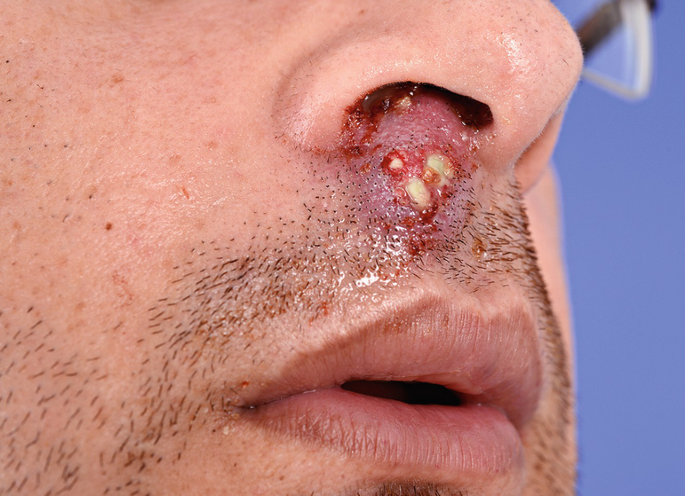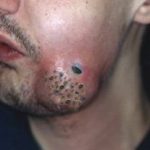🖤 What Are Blackheads?
Blackheads are a common type of acne caused by clogged pores. They appear as small, dark bumps on the skin, most often on the nose, chin, and forehead.
🔬 The Science Behind Blackheads
Your skin has sebaceous (oil) glands that produce sebum, an oily substance meant to keep skin lubricated.
When dead skin cells and excess sebum build up inside a hair follicle (a pore), they can form a plug.
If the top of the plug stays open and is exposed to air, oxidation occurs—turning the surface black. That’s a blackhead.
Unlike whiteheads (which are closed), blackheads are open comedones.
👀 What They Look Like
Tiny dark or black spots
Often seen on the nose, forehead, chin, or back
Not inflamed, but they can feel rough or bumpy
🧬 What Causes Blackheads?
Excess oil (sebum) production
Hormonal changes (especially during puberty, menstruation, or stress)
Improper cleansing
Heavy or comedogenic products (like thick makeup or greasy sunscreens)
Humidity and sweating
Genetics – some people are more prone to clogged pores
🧼 How to Prevent and Treat Blackheads
✅ Prevention
Wash your face twice daily with a gentle cleanser
Avoid heavy or pore-clogging products
Exfoliate 1–2 times per week (chemical exfoliants are preferred)
Use non-comedogenic skincare and makeup
💊 Treatment Options
Salicylic Acid
BHA that penetrates pores to dissolve oil and dead skin
Retinoids (e.g., adapalene, tretinoin)
Promote skin turnover and prevent clogged pores
Clay Masks
Help absorb oil and draw out impurities
Professional Extractions
Done by dermatologists or estheticians
Niacinamide
Helps regulate oil production and calm skin
⚠️ What Not to Do
Don’t squeeze blackheads with your fingers—it can cause scarring or push bacteria deeper
Avoid over-washing or harsh scrubbing—it can worsen oil production
⚠️ Symptoms of Blackheads
Blackheads are a type of non-inflammatory acne and are generally painless, but they have several recognizable signs. Here are the common symptoms:
🧿 1. Small Dark Bumps
Primary symptom
Usually black or dark gray in color
The dark color is not dirt, but the result of oxidation when the clogged pore is exposed to air
🌑 2. Flat or Slightly Raised Texture
Unlike pimples or cysts, blackheads are not swollen or red
May feel rough or bumpy to the touch, especially in clusters
🧴 3. Most Common in Oily Areas
Found mostly on:
Nose
Forehead
Chin
Cheeks
Back, shoulders, and chest (less common)
😌 4. No Pain or Inflammation
Blackheads are not painful
They do not cause redness, unless irritated by picking or squeezing
🪞 5. Pores Appear Enlarged
Areas with blackheads may look like they have large or open pores
🧬 Other Possible Signs
Oilier skin texture
Makeup not applying smoothly due to uneven texture
Persistent clogged pores even after washing
✅ Important: If blackheads start to become red, swollen, or painful, they may have turned into pimples (papules or pustules) or other types of inflammatory acne.
🧼 1. Cleanse Twice Daily
Use a gentle cleanser in the morning and evening.
This removes excess oil, dirt, and makeup that can clog pores.
✔️ Try:
CeraVe Foaming Facial Cleanser (normal to oily skin)
La Roche-Posay Toleriane Hydrating Gentle Cleanser (dry/sensitive skin)
🧴 2. Use Non-Comedogenic Products
Choose skincare and makeup labeled “non-comedogenic”, meaning they won’t clog pores.
Avoid heavy creams and greasy sunscreens if you’re prone to blackheads.
🧽 3. Exfoliate Regularly (1–3x per Week)
Gently sloughs off dead skin that could clog pores.
Use chemical exfoliants:
Salicylic acid (BHA): Penetrates and unclogs pores
Glycolic or lactic acid (AHA): Exfoliates surface layers
✔️ Try:
Paula’s Choice BHA Liquid Exfoliant
The Ordinary Glycolic Acid 7% Toning Solution
🧪 4. Introduce a Retinoid
Retinoids (like adapalene or tretinoin) help prevent clogged pores by speeding up cell turnover.
✔️ Over-the-counter: Differin Gel (Adapalene 0.1%)
🧖 5. Use a Clay Mask Weekly
Clay absorbs oil and pulls out impurities.
✔️ Try:
Aztec Secret Indian Healing Clay
Innisfree Super Volcanic Pore Clay Mask
🚿 6. Shower After Sweating
Sweat can mix with oil and bacteria, leading to clogged pores.
Always cleanse your skin after workouts or excessive sweating.
🔍 7. Avoid Touching Your Face
Hands carry oil and bacteria.
Picking or squeezing blackheads can lead to inflammation or scarring.
🧴 8. Moisturize Appropriately
Even oily skin needs hydration.
Use an oil-free, non-comedogenic moisturizer to prevent the skin from overproducing oil.
☀️ 9. Wear Sunscreen Daily
Sun damage can thicken the outer skin layer and clog pores.
✔️ Use a non-comedogenic SPF 30 or higher.
🧬 10. Maintain a Balanced Diet and Manage Stress
High-glycemic foods and stress may contribute to excess oil production in some people.
✅ At-Home Blackhead Treatments
1. Salicylic Acid (BHA) – #1 Ingredient for Blackheads
Oil-soluble, it penetrates deep into pores to dissolve oil and debris.
Use a cleanser, toner, or serum with 0.5%–2% salicylic acid.
✅ Product examples:
Paula’s Choice BHA Liquid Exfoliant
CeraVe Renewing SA Cleanser
2. Retinoids (Vitamin A Derivatives)
Increase cell turnover and prevent dead skin from clogging pores.
Best for persistent blackheads and oily skin.
Start with Adapalene 0.1% (available OTC).
✅ Product example:
Differin Gel (Adapalene)
3. Clay Masks
Help draw out impurities and reduce oil.
Use 1–2 times per week, especially on oily areas like the T-zone.
✅ Product examples:
Innisfree Super Volcanic Clay Mask
Aztec Secret Indian Healing Clay
4. Niacinamide
Helps regulate sebum production and reduce pore size.
Good for oily or combination skin types.
✅ Product example:
The Ordinary Niacinamide 10% + Zinc 1%
5. Chemical Peels (Mild Strength at Home)
Use exfoliants like glycolic acid, lactic acid (AHA) for surface skin renewal.
✅ Use only 1–2 times/week to avoid irritation.
⚕️ Professional Treatments (Dermatologist or Esthetician)
1. Manual Extraction
A professional can safely extract blackheads using sterile tools.
Not recommended to do yourself due to scarring risk.
2. Chemical Peels
Stronger formulas with salicylic acid, glycolic acid, or TCA.
Helps remove dead skin and reduce pore clogging.
3. Prescription Retinoids
For severe or stubborn blackheads, a doctor may prescribe tretinoin or tazarotene.
Stronger and more effective than over-the-counter options.
4. Microdermabrasion or Hydrafacial
Physical exfoliation methods that deep-clean pores.
Can smooth skin texture and help prevent buildup.
5. Laser and Light Therapy
Kills acne-causing bacteria and shrinks oil glands.
Often used for severe acne but may help with chronic blackheads too.
❌ What NOT to Do
Don’t squeeze or pick at blackheads—it can lead to scarring and infection.
Avoid harsh scrubs or over-washing, which can irritate and worsen oil production.
Don’t use pore strips too often—they may temporarily remove surface gunk but don’t solve the root problem.
🎯 Sample Basic Treatment Routine (All Skin Types)
Morning:
Gentle cleanser
Salicylic acid toner or serum
Niacinamide serum (optional)
Lightweight, non-comedogenic moisturizer
Broad-spectrum SPF 30+
Evening:
Cleanser
Retinoid (start with 2–3x/week)
Moisturizer
Weekly:
1x: Clay mask
1–2x: Gentle chemical exfoliant (AHA or BHA)


